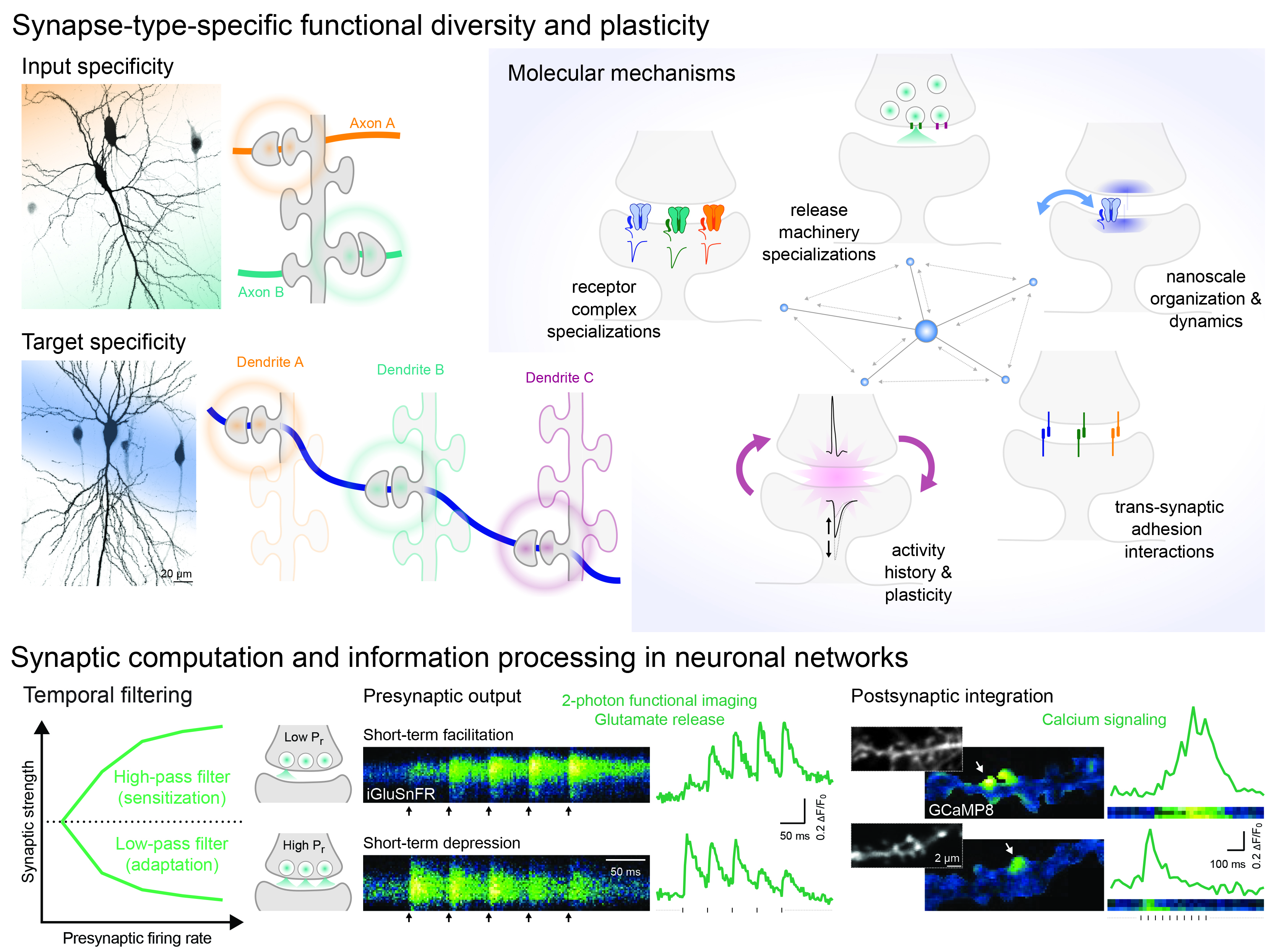Angela Getz
Assistant Professor
Synaptic function is tailored for processing distinct types of information in different circuits. The aim of our research is to understand the molecular processes that establish synapse-type-specific functional diversity and plasticity in neuronal networks. Our lab uses a combination of molecular and genetic tools, together with electrophysiology and high-resolution imaging approaches, to study how specializations in synaptic composition influence synaptic transmission properties to drive network function. We are interested in the dynamic molecular interactions that fine-tune synapse organization in different subcellular regions and brain regions, across neurodevelopment and plasticity, and in brain disorders associated with synapse dysfunction.

A number of structural and molecular specializations diversify the transmission, reception, and signal processing mechanisms employed at different types of synapses. This gives rise to distinct forms of frequency- and activity-dependent plasticity that underlie spatiotemporal filtering properties and adaptive information processing in neuronal networks. Higher brain functions such as sensory perception, decision making, and working memory are also thought to rely on the input/output computations mediated by synapses. Many neurological conditions are linked to synaptopathies that alter synaptic structure and function, and consequently compromise the brain’s ability to effectively process and store information.
Previous work has established that pre- and post-synaptic mechanisms synergistically tune signal generation and integration to adapt synaptic transmission efficacy. Whereas synapse-type-specific plasticity has been well characterized at the network level, it remains incompletely understood at the molecular level. We are investigating how differences in synaptic protein interactomes influence neurotransmitter release machinery and postsynaptic receptor complexes to tune synaptic transmission efficacy and plasticity. Our general aim is to uncover how specializations in the molecular composition and nanoscale organization of synapses are established and modified by input-specific and activity-dependent signalling interactions to stably and dynamically regulate synaptic communication and information processing in neuronal circuits.
Synaptic specificity arises from fine-scale interactions between pre- and postsynaptic elements and their unique genetic and molecular environments. In our research, we combine advanced molecular tools and imaging techniques for visualizing and manipulating synaptic organization and function in integrated experimental models, using brain slice and in vivo preparations. This includes CRISPR/Cas9-mediated genome editing to functionalize endogenous synaptic proteins targets for labelling specific neuronal populations, functional imaging approaches using fluorescent biosensors and optogenetic tools with 2-photon microscopy, and fast 4D and superresolution imaging of the molecular dynamics and nanoscale organization of synaptic proteins with lattice light-sheet microscopy. Together, these techniques allow us to explore synaptic dynamics in situ with unprecedented precision and resolution.
(1) Visualization of endogenous synaptic proteins expressed on the neuronal surface (red, AMPA-type ionotropic glutamate receptors), revealed with the AP-tag knock-in toolkit and sparse avidin-biotin labeling (Getz et al., 2022).
(2) 4D imaging of spine dynamics during long-term plasticity, induced by spine-targeted photo-activation of paCaMKII (Nowacka & Getz et al., 2024).
(3) Single molecule localization microscopy (red, DNA-PAINT of GFP) for super-resolution imaging of spine structure in 3D (Malivert et al., in preparation).
Images acquired with lattice light-sheet microscopy at the Bordeaux Imaging Center.
We are always interested in new talent. For the latest positions and news from the lab, check out @ang_getz on X.
Nowacka A# & Getz A*#, Zieger H, Bessa-Neto D, Breillat C, Daburon S, Lemoigne C, Marais S, Ducros M, Penn AC, Sainlos M, Choquet D*. Synapse specific and plasticity-regulated AMPAR mobility tunes synaptic integration. bioRxiv. doi: 10.1101/2024.03.19.584837.
#, Co-first author, equal contribution; *, Corresponding author.
Nowacka A, Getz A, Bessa-Neto D, Choquet D (2024). Activity-dependent diffusion-trapping of AMPA receptors as a key step for expression of early LTP. Phil. Trans. R. Soc. B 379: 20230220. doi: 10.1098/rstb.2023.0220.
Getz A, Ducros M, Breillat C, Lampin-Saint-Amaux A, Daburon S, François U, Nowacka A, Fernandez-Monreal M, Hosy E, Lanore F, Zieger H, Sainlos M, Humeau Y, Choquet D (2022). High-resolution imaging and manipulation of endogenous AMPA receptor surface mobility during synaptic plasticity and learning. Science Advances 8(30). doi: 10.1126/sciadv.abm5298.
Getz A*, Janes TA, Visser F, Zaidi W, & Syed NI* (2020). Neurotrophic factors and target-specific retrograde signaling interactions define the specificity of classical and neuropeptide cotransmitter release at identified Lymnaea synapses. Scientific Reports. 10(1):13526. doi: 10.1038/s41598-020-70322-5.
*, Corresponding author.
Ducros M, Getz A, Arizono M, Pecoraro V, Fernandez-Monreal M, Nägerl UV & Choquet D (2019). Lattice light sheet microscopy and photo-stimulation in brain slices. Proc. SPIE. 10865, Neural Imaging and Sensing 2019; 1086508. doi: 10.1117/12.2509467.
Getz A, Xu F, Visser F, Persson R & Syed NI (2017). Tumor suppressor menin is required for subunit-specific nAChR α5 transcription and nAChR-dependent presynaptic facilitation in cultured mouse hippocampal neurons. Scientific Reports. 7, 1768; doi: 10.1038/s41598-017-01825-x.
Getz A, Visser F, Bell EM, Xu F, Flynn NM, Zaidi W & Syed NI (2016). Two proteolytic fragments of menin coordinate the nuclear transcription and postsynaptic clustering of neurotransmitter receptors during synaptogenesis between Lymnaea neurons. Scientific Reports. 6, 31779; doi: 10.1038/srep31779.